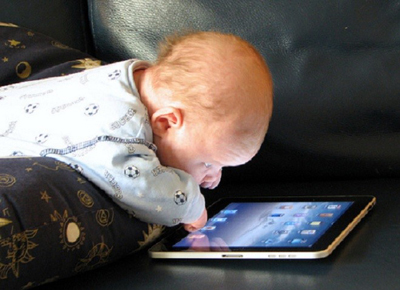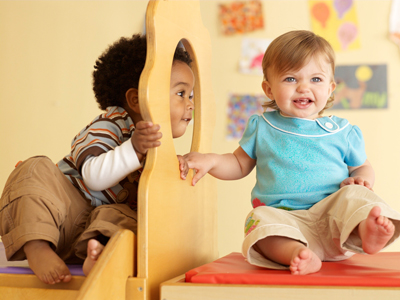The iPad is a Far Bigger Threat to Our Children Than Anyone Realizes
by psychologist Sue Palmer
Ten years ago, I predicted the toxic effects of social media. Now I sees a worrying new danger.
When the little girl pointed at the sweets at the checkout, her mother said: “No, they’re bad for your teeth.ˮ So her daughter, who was no more than two, did what small children often do at such times. She threw a tantrum.

What happened next horrified me. The embarrassed mother found her iPad in her bag and thrust it into her daughter’s hands. Peace was restored immediately.
This incident, which happened in 2013, was the first time I saw a tablet computer used as a pacifier. It certainly wasn’t the last. Since then, I’ve seen many tiny children barely able to toddle yet expertly swiping an iPad – not to mention countless teenagers, smartphone in hand, lost to the real world as they tap out texts.
It’s 12 years since the publication of my book, Toxic Childhood, which warned of the dangers of too much screen-time on young people’s physical and mental health. My fears have been realised. Though I was one of the first to foresee how insidiously technology would penetrate youngsters’ lives, even I’ve been stunned at how quickly even the tiniest have become slaves to screens – and how utterly older ones are defined by their virtual personas.
Indeed, when my book came out, Facebook had just hit our shores and we were more concerned with violent video games and children watching too much TV. Seems like ancient history, doesn’t it? Today, on average, children spend five to six hours a day staring at screens. And they’re often on two or more screens at once – for example, watching TV while playing on an iPad.
Because technology moves so fast, and children have embraced it so quickly, it’s been difficult for parents to control it. And when it comes to spending a childhood in front of a screen, this generation are like lab rats. The long-term impact is not known.
Even before iPads hit the market in 2010, experts were warning that 80 per cent of children arrived at school with poor co-ordination, due to a sedentary lifestyle.

Sue Palmer, above, believes that excessive screen time can lead to obesity, sleep disorders and aggression
Along with colleagues in the field of child development, I’d seen a rise in prescriptions for Ritalin, a drug for attention deficit and hyperactivity – a four-fold increase in less than a decade. And we’d collected a mass of research showing links between excessive screen-time and obesity, sleep disorders, aggression, poor social skills, depression and academic under-achievement.
It’s little wonder, then, that the boom in iPads and smartphones has coincided with further deterioration in the physical and mental health of children of all ages. Sadly, we’re seeing the rise of the ‘techno-tot’ for whom iPads have become the modern-day equivalent of a comfort blanket.
Recent research found 10 per cent of children under four are put to bed with a tablet computer to play with as they fall asleep. One study of families owning them found a third of children under three had their own tablets. Baby shops even sell ‘apptivity seats’ into which a tablet can be slotted to keep toddlers entertained.
Few know that the late Apple boss Steve Jobs didn’t let his own children have iPads. I wish he had gone public on this as other parents might have followed suit. Because the earlier children are hooked on screens, the more difficult it is to wean them off.
This is not the only worry. It’s not just what children get up to onscreen that affects their overall development. It’s what screens displace – all the activities they’re not doing in the real world. Today’s children have far fewer opportunities for what I call ‘real play’. They are no longer learning through first-hand experiences how to be human and are much less likely to play or socialize outdoors or with others.
One of the most depressing examples of a totally screen-based childhood involved a ten-year-old in London. The overweight, pasty-faced little lad told me: “I sit in my room and I watch my telly and play on my computer. And if I get hungry I text down to my mum and she brings me up a pizza.ˮ The change in children’s play has happened in little more than a couple of decades. While many parents feel uneasy about all that screen-time, they haven’t tackled it as they’ve been so busy keeping up with changes in their own lives.
And anyway, it’s happening to children everywhere – so surely it can’t be bad for them?
But real play is a biological necessity. One psychologist told me it was “as vital for healthy development as food or sleepˮ.
If the neural pathways that control social and imaginative responses aren’t developed in early childhood, it’s difficult to revive them later. A whole generation could grow up without the mental ability to create their own fun, devise their own games and enjoy real friendships – all because of endless screen-time.
It’s getting out and about – running, climbing, making dens and so on – that allows little children to gain physical skills. Playing “let’s pretendˮ is a creative process requiring lots of personal input.
Real play develops initiative, problem-solving skills and many other positive traits, such as a can-do attitude, perseverance and emotional resilience. It’s vital for social skills, too. By playing together, youngsters learn to get along with other people. They discover how others’ minds work, developing empathy. And, as real play is driven by an innate desire to understand how the world works, it provides the foundation for academic learning. Real play is evolution’s way of helping children develop minds of their own – curious, problem-solving, adaptable, human minds.
The American Academy of Paediatrics recommends no screen-time for children under two and a maximum two hours a day there-after. This is not just due to a proven link between screen-time and attention disorders, but because it eliminates other activities essential for building healthy bodies and brains.
Babies are born with an intense desire to learn about their world, so they’re highly motivated to interact with people and objects around them – the beginning of real play. That’s why they love it when we play silly games with them, such as peekaboo, or they manage to grasp some household object. This is what helps them develop physical co-ordination and social skills.

But when little ones can get instant rewards from high-tech devices, they don’t need to bother with real play. Images on a screen can be just as fascinating as the real world, and even a very small child can learn to control the images with a clumsy swish of podgy fingers.
Each time babies or toddlers make something happen on screen, they get the same sort of pleasure hit as they would from a cuddle or a splash in the bath. When they can get instant rewards by swiping a screen, why bother with play that demands physical, social and cognitive effort?
Neuroscientist Susan Greenfield said: “We cannot park our children in front of screens and expect them to develop a long attention span.ˮ
She also worries about the effects of technology on literacy. “Learning to read helps children learn to put ideas into logical order,ˮ she says. “On the other hand, staring at a screen puts their brains into suspended animation.ˮ
Dr Aric Sigman, who has amassed a huge database of research linking children’s screen-time to ADHD, autism and emotional and behavioural disorders, also points to the conflict between screen-based activity and reading.
“Unlike screen images, words don’t move, make noises, sing or dance. Ultimately, screen images render the printed word simply boring at a crucial phase when the child’s mind is developing,ˮ he said.
Yet another problem with too much screen-gazing is that it doesn’t develop resilience.
Real play gives children opportunities to learn how to cope with challenges for themselves. Finding how to learn from their mistakes, picking themselves up when they take a tumble and sorting out squabbles with playmates all help develop the self-confidence that makes children more emotionally resilient.
This is vital for mental health, especially in our high-pressure world. So I wasn’t surprised when in January 2016 Childline warned Britain is producing deeply unhappy youngsters – sad, lonely, with low self-esteem and an increasing predilection to self-harm. The charity painted a bleak portrait of our children’s emotional state, blaming their unhappiness on social networking and cyber-bullying.
It’s understandable parents feel unable to tackle their children’s social media use. After all, it has spread like a virus. In 2012, just six years after Facebook arrived here, it was the favourite website of ten-year-old girls.
That year I interviewed three 15-year-old girls in Yorkshire who have been on Facebook since the age of ten. They said they didn’t enjoy it as much as “when we were youngˮ because “running our own PR campaignsˮ – as they wittily described the constant need to make their lives sound glamorous and exciting – was exhausting and they often felt miserable when others seemed to be having more fun.
But they couldn’t give up the social media site as it would put them out of the social loop. “There’s lots of cyber-bullying,ˮ one said. “So you’ve got to try to be like everyone else.ˮ
But we can’t go on letting our children “be like everyone elseˮ when it’s damaging them. If the next generation is to grow up bright, balanced and healthy enough to use technology wisely, parents need to take action. And that means limiting screen-time, spending time together as a family and making sure get children out to play.
Some say children need to use technology because that’s the way the world is going. But there’s no need to give little children high-tech devices.
Modern technology develops at a phenomenal rate – any IT skills that children learn before the age of seven will be long past their sell-by date by the time they reach their teens. But self-confidence, emotional resilience, creative thinking, social skills and the capacity for focused thought will stand them in good stead whatever the future brings.
yogaesoteric
June 2, 2018
